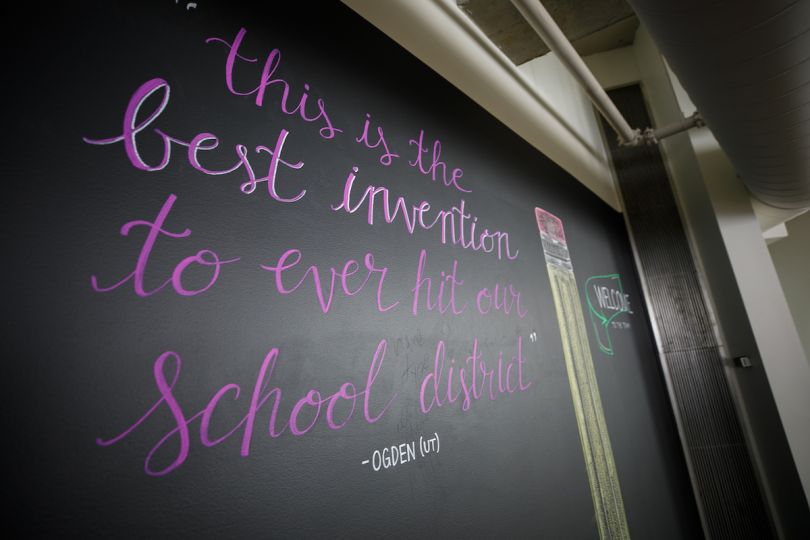Ali DiNardo joined Teach For America in 2013. She taught second and then third grade in the Houston Independent School District.
DiNardo loved teaching, and she noticed that Teach For America took a data-driven approach to its work. When she finished her time at Teach For America, she decided to transition to a data-centric career in hopes of leveraging analytics to make an impact for students.
That led her to Panorama Education, where as senior group product manager, she can combine her two passions: education and data.
“Panorama is all about how we enable data-based decision making for stakeholders in support of student outcomes,” DiNardo said. “It’s this perfect place for me to bring that together.”
Mission Success Is Student Success
“Our product and our work are deeply tied to our mission, vision and values,” Robinson said. Panorama’s mission is to radically improve student outcomes. To do that, the product team is trying to effect four changes: supporting every student, supporting the whole child, helping educators build thriving communities and helping educators continuously improve.
DiNardo is just one of Panorama’s product managers who has experience in the education system. It’s a concerted hiring choice Panorama makes.
“It brings together product skills that are relevant in any vertical with the mission focus and this deep commitment to student impact,” said Sarah Robinson, vice president of product.
Panorama strives to serve all the different stakeholders who support and care about students, including teachers, families and administrators from the school to the district. The product team also considers data that covers academics, well-being, behavior, attendance and social-emotional skills. That data facilitates a cycle of holistic decision-making through two of Panorama’s products, Panorama for Positive Behavior and Panorama Student Success.
Robinson has a vision for her team. She wants excellent product managers who are dedicated to their bread and butter: providing value to users. But she also wants her team to invest in and focus on the product impact. After all, it’s not just user experience on the line. It’s student success.
“Every day is this healthy obsession with the educator experience and how we can make it better. But we have to go beyond that,” Robinson said. “We have to think about student impact, and when those things are different, that’s a really interesting space to explore.”

A positive approach
Product Manager Raquel Levy recently visited a few of Panorama’s district partners in person to observe how schools use the products day to day.
“It’s a very different strategy than thinking on Zoom together,” Levy said.
Beyond site visits, Levy and other product managers join calls with clients to uncover their problems and glean customer feedback. Those inputs help Panorama to prioritize the direction of its products. They also lean on news, data and research from Panorama’s research team to further understand and empathize with the issues students and teachers face.
Once Panorama designs a solution, it’s tested with real users so the team can receive feedback before it builds the final product.
“That ensures we’re validating as we go and solving real and important problems for educators in a way that makes sense for them,” Levy said.
Panorama’s approach to product design came to life with Panorama for Positive Behavior, which solves student behavioral challenges. The new product started with an understanding of the challenges students and educators were facing when it comes to fostering positive behaviors and learning environments.
Thanks to Panorama’s strong feedback loops, Panorama saw that behavioral issues were increasing following remote learning during the peaks of the pandemic. Educators sought behavior data to inform decision making, but the effort to record incidents was high with disparate systems or limited information.
Teachers also needed actionable analytics and reporting to understand what to do. But reporting was hard to scale and lacked insights. Without the necessary insights, teachers were left to respond to behaviors instead of stymieing them with preventive techniques.
“There’s this constant refrain of educators being in firefighting mode, reacting to behaviors that are coming up and feeling helpless at times,” DiNardo said.
The Panorama team started to look for ways to support educating in promoting positive behaviors and mitigating challenging ones.
Positive behavior gets a boost
Panorama for Positive Behavior’s behavior logging system allows teachers to capture minor and major behavior issues. The tool helps teachers to recognize opportunities to reinforce positive behaviors as opposed to reacting to negative ones with a consequence. “We want to shift the focus to the adult behavior, which is in our control,” DiNardo said. Behavior Boost, which enables proactive support, helps educators set goals to reinforce positive behavior and then reflect on the impact of their efforts over time.
First, they incorporated a user-friendly behavior logging solution into the platform. Positive Behavior also provides tools for teachers and staff to improve the school and classroom climate with positive behavioral supports, like behavior-specific praise.
“We created dashboards, key performance indicators, and other views that show both the impact that educators are having and opportunities and insights for how to take action and support both students and staff alike,” DiNardo said.
After validating Positive Behavior, it officially launched. But as an early stage product, “it’s never one-and-done,” DiNardo said.
“We’re constantly growing,” she continued. “We’re excited to partner with our early adopters to see how we can evolve it to make it better.

Ensuring equity and opportunity
While Panorama for Positive Behavior focuses on preventing challenging behaviors by reinforcing positive ones, Panorama Student Success ties the behavior component of student success to the whole child.
It’s the systemic piece of the Panorama puzzle. Say a student is struggling with math. With Student Success, his or her teacher could easily log in and discover that their attendance is low, particularly in the morning.
Upon further research, the math teacher could uncover the student doesn’t have a ride to school. The teacher would subsequently be able to identify a solution that not only improves the student’s attendance, but also his or her math grades.
“We can help educators draw connections across the different domains.”
Without Student Success, that math teacher might focus on academic interventions to improve the student’s math scores. But with Student Success, she sees all the pieces that affect academic outcomes.
On a student’s profile, educators can access behavior data from systems like Positive Behavior, as well as data about academics, social emotional learning competencies, which comes from SEL surveys that districts can run with Panorama, and attendance.
“Those different inputs come together in one view, and we can help educators draw connections across the different domains,” Levy said. “It helps them take a systemic approach and understand how these domains work together to get to the root cause of how to support a student.”
Small Steps Forward
Panorama’s product team regularly reflects on the value “progress over perfection.” In addition to their desire to continually invest in the product, it manifests in how Panorama strives to propel educators toward big change through small and meaningful wins. Panorama’s product updates focus on increasing efficiencies in navigating the product for busy educators. For example, the product team updated Student Success to allow teachers to reopen intervention plans to make updates. It also enabled teachers to add external documentation to plans, so behavior information is located in one system.
“If we can help build those social emotional capabilities, maybe we’ll see a decrease in certain behaviors, and the student can focus better in class and we may see academic improvements as well,” Levy said.
Student Success is built around multi-tiered systems of support, a framework that ensures students with the highest levels of need receive assistance.
“We believe that framework is a great way to ensure that kids who may not be receiving an equitable educational experience will be flagged by that system, and educators will find ways to implement supports that directly meet those needs,” Levy said.
Administrators can break down data by demographic groups, which allows them to see inequities in what groups of students are excelling. It helps them to understand how, as a school system, educators can meet the needs of different demographics.
“We focus on making the entire school system more equitable, instead of just focusing on the needs of specific students here and there,” Levy said.
To do that, an intervention planning module allows educators to document a support with a strategy and timeframe for implementation. Then they can easily monitor their progress.
“It’s going from just identifying students who need additional support to having all the tools you need to actually plan those supports and track them over time,” Levy said.
The platform informs at the classroom and individual level all the way up to the school and district levels for equity-based initiatives and programs dedicated to improving student outcomes, like graduation rates or a sense of belonging.
“We focus on making the entire school system more equitable, instead of just focusing on the needs of specific students here and there.”
Take Everett High School in Washington. With Panorama’s products, which facilitated a focus on SEL and its impact on college, career and life readiness, the school took its graduation rate from 62 percent to 95.9 percent.
That’s Levy’s why. The entire product team has a passion for education and a strong focus on student impact, and it inspires her to see the scope of reach they have to actually change education for the better.
“That makes me hopeful for how we can impact the lives of students, help them get access to the opportunities they want and help them get the best possible educational experience,” Levy said.








